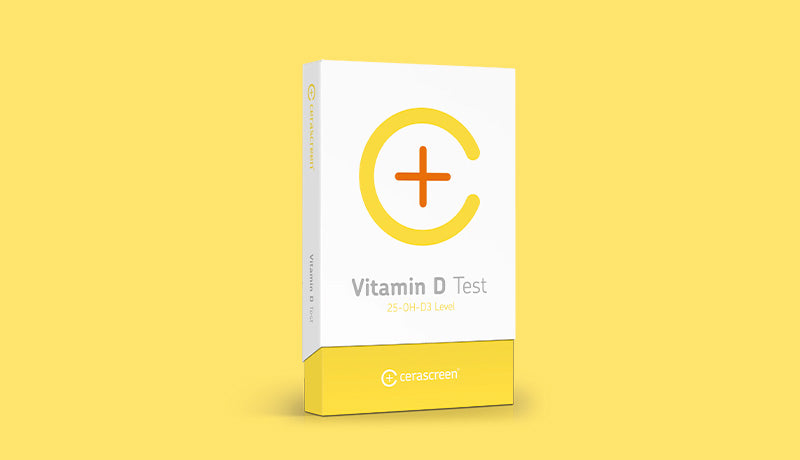Why do we need vitamin D? Without consuming vitamin D through nutritional supplements, it is difficult to truly optimise your vitamin D levels all year round – especially when sunshine is sparse. This has been confirmed after cerascreen® analysed more than 22,000 of its vitamin D test results.
Did you know that 30 to 40 per cent of people in the United Kingdom are severely vitamin D deficient in winter and 13 per cent in summer?[7] And with people spending more and more time indoors during winter and during the pandemic, it’s no wonder that many people these days want to proactively take their health into their own hands by turning to and reaping the benefits of vitamin D supplements.
Taking vitamin D through supplements has proven beneficial according to the results of cerascreen®’s vitamin D tests, which were carried out between September 2020 and August 2021. They reveal that people who do not take supplements do not succeed in reaching recommended vitamin D levels naturally. In the long run, this can lead to vitamin D deficiency.
Find out more about the results of our survey and why we need vitamin D to stay healthy – particularly during a pandemic. Explore the benefits of vitamin D supplements and whether they are safe to gain science-backed insights into how much vitamin D you should take and when to take vitamin D.
Why do we need vitamin D: what does our data show?
When activating their test online, customers who take the cerascreen® Vitamin D Test answer a number of questions that are considered when compiling their personal result reports. These questions also serve to help those working in the laboratories and on the results reports to anonymously analyse the results for scientific purposes. One of the questions we asked was whether our customer takes vitamin D supplements.
We analysed the data we received and discovered some interesting correlations, which indicate the benefits of vitamin D supplements and when to take vitamin D:
- People taking vitamin D supplements consistently had higher vitamin D levels, which were, on average, within the range experts would describe as an optimal vitamin D level.
- The levels of people taking vitamin D hardly fluctuated over the course of the year and were even slightly lower in summer than in winter.
- The levels of people not taking vitamin D, in turn, fluctuate significantly and are much higher in summer than in winter.
- The vitamin D levels of those not taking supplements hover below the minimum recommended 30 nanogrammes per millilitre throughout the year.
Why would someone have lower vitamin D levels in summer? Some people taking vitamin D supplements had slightly lower levels in summer than in winter. We can only guess the reason behind this. It may well be that people take fewer supplements, or even none at all, during the warm season because they assume that their bodies can produce more vitamin D through exposure to sunlight.
How did we carry out our analysis?
We analysed data from 22,431 customers who took a vitamin D test between September 2020 and August 2021. Most of the tests were taken in Germany, with some also in Austria, Switzerland and the United Kingdom.
Our specialist laboratories determined vitamin D levels from blood samples sent in by our customers. All customers whose data were included in this analysis had answered the question as to whether they were taking vitamin D supplements or not.
After analysing the data we received, we had evidence to suggest that many people in Europe do not manage to reach the recommended vitamin D levels if they do not take supplements. These people had significantly lower vitamin D levels in winter than in summer.
What are the benefits of vitamin D supplements?
Why do we need vitamin D? Our bodies can only produce enough vitamin D if it is exposed to UV radiation from the sun. It is, of course, called the sunshine vitamin for a reason. In certain states – not just in the United Kingdom but across the globe – many people do not manage to stock up on enough vitamin D in summer to keep their vitamin D reserves going through the winter.[2]
You can read more about vitamin D exposure about how it affects our skin in our article on sun allergy.
Nutritional supplements, on the other hand, can provide you with vitamin D all year round. Experts recommend taking 800 international units of vitamin D a day if you do not receive enough exposure to direct sunlight – which is the case for many people during the winter months, but also, for example, for people who are not able to leave the house or who tend to stay indoors.[3] You should only take higher dosages if you have tested your vitamin D levels beforehand.
What about getting our vitamin D from the foods we eat? We can also get vitamin D from certain foods, such as fatty fish and mushrooms. But our diet can only contribute to a small part of our vitamin D intake and cannot replace sunlight.
What vitamin D supplements should I take?
You can take vitamin D in different forms. The most common forms are drops, capsules and tablets. They each have their advantages and disadvantages, but they all reliably maintain or boost vitamin D levels.
Drops are ideal for many people, in that you can dose them very flexibly – and you can just mix them into a meal or drink if you don’t enjoy the taste. If you want to halve your daily dose from one day to the next, you simply take half as many drops. One disadvantage is that the dosage is somewhat less accurate than with other dosage forms because drops that come out of the pipette are not always the same size.
You can take capsules and tablets with a sip of water. Here, you usually have to decide on your vitamin D dosage beforehand, but you can at least be sure that you will take exactly the same amount each time. For people who have no problem swallowing larger tablets or capsules, this form of vitamin D supplement is therefore also a good option.
When to take vitamin D: should I take vitamin D with a meal?
It does not matter at what time of day you take your vitamin D supplements. Some people tolerate supplements less well at certain times of the day – for example, in the evening. You should just try out when taking vitamin D suits you best.
As vitamin D is a fat-soluble vitamin, you should take it with or after a meal. Some studies recommend taking the vitamin at your biggest meal of the day to ensure your body absorbs it best – in any case, the food should contain some fat. This is usually not necessary with vitamin D drops, however, in which the vitamin is already dissolved in oil.[4, 5]
Our tip: Establish a routine for yourself so you don’t forget to take vitamin D. For example, if you always take vitamin D after breakfast, you will make a habit of associating your breakfast with taking supplements – and you’ll combine your supplementation with a meal.
How much vitamin D should I take?
The American Society of Endocrinology, for example, recommends taking 1,500 to 2,000 international units per day to bring vitamin D levels above the 30 ng/ml level. If you have confirmed a vitamin D deficiency, taking a higher dose should help you restore optimal vitamin D levels.[6]
There are also high-dose supplements that are meant to be taken once a week. Since vitamin D is stored in the body, it makes no difference whether you take 1,000 international units every day for seven days or 7,000 international units once a week.
If you take drops, you can also regulate your intake like this yourself. As a rule, one drop corresponds to 1,000 international units. There are also very high-dose supplements on the market containing up to 20,000 international units of vitamin D, which would supply you with vitamin D for several weeks.
Are vitamin D supplements safe?
Be careful with high-dose supplements – if your vitamin D levels are already good but you choose to increase them further, you might overdose on vitamin D. This can lead to kidney damage, among other things. This is another reason why you should check your vitamin D levels before taking supplements.
Sources
[1] Robert Koch-Institut, “Vitamin-D-Status von Erwachsenen in Deutschland,” 2016, doi: 10.17886/RKI-GBE-2016-036.
[2] Biesalski H.-K., Grimm P., Nowitzki-Grimm S. Taschenatlas der Ernährung, 4., Überarb. und erw. Aufl. Stuttgart: Thieme, 2007.
[3] Deutsche Gesellschaft für Ernährung “Vitamin D“ available at https://www.dge.de/wissenschaft/referenzwerte/vitamin-d/?L=0, accessed on 11 October 2021.
[4] Mulligan G. B., Licata A. “Taking vitamin D with the largest meal improves absorption and results in higher serum levels of 25-hydroxyvitamin D“, J. Bone Miner. Res. Off. J. Am. Soc. Bone Miner. Res., vol. 25(4), pp. 928–930, April 2010, doi: 10.1002/jbmr.67.
[5] Dawson-Hughes B., Harris S. S., Lichtenstein A. H., Dolnikowski G., Palermo N. J., Rasmussen H. “Dietary fat increases vitamin D-3 absorption“, J. Acad. Nutr. Diet., vol. 115(2), pp. 225–230, February 2015, doi: 10.1016/j.jand.2014.09.014.
[6] Holick M. F. et al, “Evaluation, treatment, and prevention of vitamin D deficiency: an Endocrine Society clinical practice guideline“, J. Clin. Endocrinol. Metab., vol. 96(7), pp. 1911–1930, July 2011, doi: 10.1210/jc.2011-0385.
[7] Calame, W., Street, L., Hulshof, T. “Vitamin D Serum Levels in the UK Population, including a Mathematical Approach to Evaluate the Impact of Vitamin D Fortified Ready-to-Eat Breakfast Cereals: Application of the NDNS Database,” Nutrients, 12(6), 2020, 1868. https://doi.org/10.3390/nu12061868



